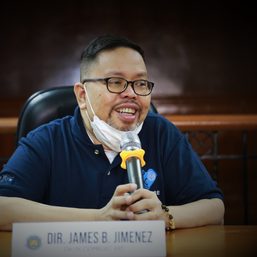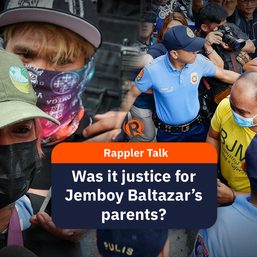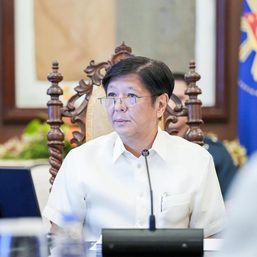SUMMARY
This is AI generated summarization, which may have errors. For context, always refer to the full article.
![[Newsstand] The shape of bullshit: Flattening the discourse](https://www.rappler.com/tachyon/2022/05/shape-of-bullshit-may-31-2022.jpg)
The day after Congress proclaimed him president-elect, Ferdinand Marcos Jr. held a news conference with only three news organizations in attendance. GMA Network, the country’s largest, was one of the three invited; the others were the two religion-owned broadcasting channels favored by and partial to the Marcos presidential campaign, Net 25 and SMNI.
None of the other news organizations were invited. In fact, the Marcos campaign team issued an advisory that the BBM Media Center, where the selective news conference was eventually held, would “still be closed” that Thursday. The rest of Philippine media were left to scramble and follow the briefing on social media.
The news conference, the president-elect’s first ever, was wrong on many levels. Let me highlight a troubling aspect of it that implements, and explains, a key Marcos Jr. communications strategy. By lumping the openly partisan SMNI and Net 25 with independent, professional GMA, the Marcos administration-in-the-making was continuing its attempt to legitimize the two other channels.
Or, to be more precise, it was continuing its long-term effort to erase any significant distinctions between news organizations like GMA (institutionally meek when it comes to press freedom issues, but the home of courageous, highly competent individual journalists and numerous prizewinning programs of high journalistic quality) and the Marcos propaganda infrastructure, including its nascent versions of alternate-reality network Fox News. In other words, the selective news conference was yet another attempt at flattening the discourse.
No distinctions
This is a signature Marcos strategy, which the recent elections placed in sharp relief.
When Marcos Jr. was ridiculed for avoiding potentially adversarial debates or even Jessica Soho’s one-on-one presidential interview, he decided to show up at SMNI’s debate, which was friendly by design. His presence (highlighted by the surreal exchange over Niccolo Machiavelli) did not stem the tide of criticism from supporters of other presidential candidates, but it did allow his supporters to deflect the criticism or to discount it. In short, they flattened the public conversation about debates by playing up his SMNI appearance.
Other examples include flattening public talk over the size of the Robredo campaign rallies by mounting their own large rallies and preempting headlines by overcounting the turnout, or deflecting from Marcos Jr’s sometimes embarrassing stump speeches (for instance, the “alamano” fiasco) by ramping up the spurious “lutang” or airhead criticism against Leni Robredo. In this light, even the usual hijacking of social media trends – for instance, when the Robredo campaign’s #KulayRosasAngBukas campaign (literally, The Future is Rosy) became viral, Marcos supporters moved immediately to red-tag the trend with #PulaAngKulayNgRosas (Roses are Red) – can also be understood as a kind of discourse-flattening.
The pioneering research by scholars Cheryll Ruth Soriano and Fatima Gaw into pro-Marcos content on YouTube gives many examples of this flattening. For instance, Soriano identifies a true, working democracy as one of the “aspirational tropes” that characterize the Marcos legacy, as it is presented on YouTube. That is, Marcos the dictator was, at least on that popular platform, a genuine democrat; this astonishing claim can be made because of the argument that a functional democracy needs a “disciplined citizenry” (code for authoritarian control). But the claim already conflates all talk of democracy, and includes Marcos in it.
It is common these days to use the term “gaslighting” to refer to deceptive and manipulative communication, a reference to the 1944 movie “Gaslight.” But there is I think an even older term with equal explanatory power, with the additional advantage of being familiar to us even in a Filipino context. I mean the word “bullshit.”
Official BS
The way campaign spokesperson and incoming executive secretary Vic Rodriguez explained Thursday’s selective news conference was an example of the bullshit that’s meant to flatten the discourse.
He said the three networks were invited to the selective news conference because they had pending requests for one-on-one interviews with Marcos in the event he won the election. But in fact, many other news organizations made similar requests (which are, of course, only to be expected in a winning campaign). It is an established fact that Net 25 and SMNI have enjoyed preferential access to the candidate throughout the campaign. And there was no need to advice the rest of the media that the media center would be closed if, in fact, it was open.
Rodriguez even characterized the decision to accept the one-on-one requests simultaneously as an effort “to be fair” – a ridiculous assertion on its face, not only because the original requests were for exclusives but also because shutting out the other media from the first news conference was anything but fair.
But this explanation-that-does-not-explain is enough to give Marcos supporters the basis to deflect from the controversy or to discount it. It was not rooted in the truth of the situation; it wasn’t even interested in keeping appearances, in looking plausible. “It is just this lack of connection to a concern with truth—this indifference to how things really are—that I regard as of the essence of bullshit,” the moral philosopher Harry F. Frankfurt writes in “On Bullshit.”
This is familiar behavior, because this is President Duterte’s brand of rhetoric. He is not so much a liar, as he is a bullshit artist. Much of the Marcos propaganda and disinformation we have consumed over the years belongs to the same category. Frankfurt writes: “the essence of bullshit is not that it is false but that it is phony.” This stands the whole argument about “authenticity” on its head. Frankfurt again: “What is wrong with a counterfeit is not what it is like, but how it was made.”
Value chain
Consider the president-elect’s labored defense of his irresponsible campaign suggestion that the price of rice be halved to P20 a kilo. He began by describing the P20 price as an “aspiration,” which we can reach “if we work very hard.” How exactly? When we can complete what we call the value chain, he said mostly in Filipino. “You have to do research and development, finding new varieties, finding new techniques.” Then find “alternatives” to today’s fertilizers and then solve “how … we … mass produce them.” Finally, “we have to bring all these new technologies to the farmers and we have to teach them.”
His original and urgent campaign promise of placing a price cap on rice is no longer mentioned. In its lieu, we have a hodgepodge of aspirational possibilities.
Frankfurt was right. “Bullshit is unavoidable whenever circumstances require someone to talk without knowing what he is talking about.” In Marcos Jr’s case, the hard rain of jargon (value chain, R&D, new varieties, organic, new technologies) washes away the asphalt of common sense, leaving the road – more or less, aspirationally – flat. (Up next: The shape of bullshit: Convexing the reality.) – Rappler.com
Veteran journalist John Nery is a Rappler columnist, program anchor, and editorial consultant.
Add a comment
How does this make you feel?
![[WATCH] In The Public Square with John Nery: Preloaded elections?](https://www.rappler.com/tachyon/2023/04/In-the-Public-Square-LS-SQ.jpg?resize=257%2C257&crop=414px%2C0px%2C1080px%2C1080px)
![[Newspoint] 19 million reasons](https://www.rappler.com/tachyon/2022/12/Newspoint-19-million-reasons-December-31-2022.jpg?resize=257%2C257&crop=181px%2C0px%2C900px%2C900px)

![[OPINION] The long revolution: Voices from the ground](https://www.rappler.com/tachyon/2022/06/Long-revolution-June-30-2022.jpg?resize=257%2C257&crop=239px%2C0px%2C720px%2C720px)
![[OPINION] I was called a ‘terrorist supporter’ while observing the Philippine elections](https://www.rappler.com/tachyon/2022/06/RT-poster-blurred.jpeg?resize=257%2C257&crop_strategy=attention)




![[New School] Tama na kayo](https://www.rappler.com/tachyon/2024/02/new-school-tama-na-kayo-feb-6-2024.jpg?resize=257%2C257&crop=290px%2C0px%2C720px%2C720px)




![[WATCH] #TheLeaderIWant: Filipino voters sound off on community issues a year before 2025 elections](https://www.rappler.com/tachyon/2024/05/filipino-voters-sound-off-on-community-issues-1.jpg?resize=257%2C257&crop=276px%2C0px%2C720px%2C720px)
There are no comments yet. Add your comment to start the conversation.